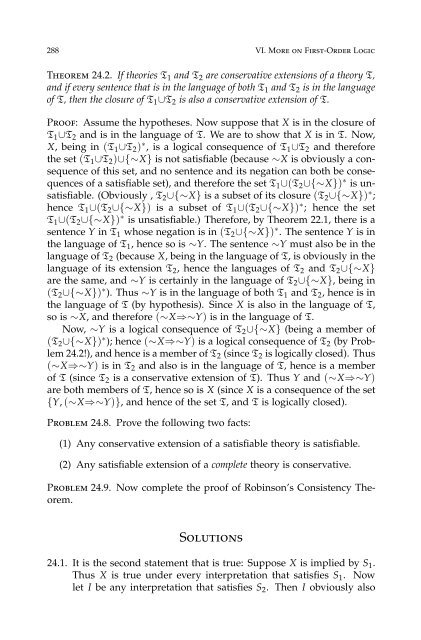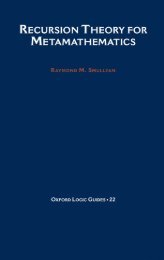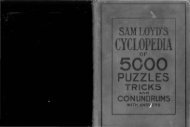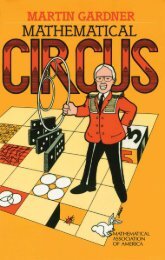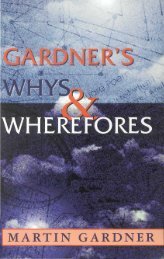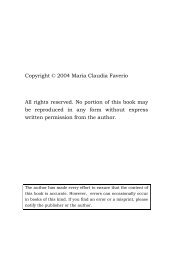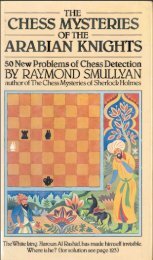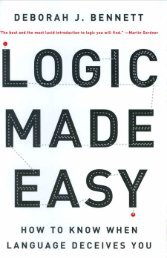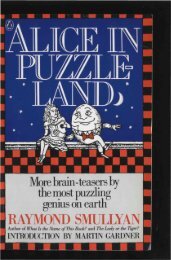- Page 2 and 3:
Logical Labyrinths
- Page 4:
Editorial, Sales, and Customer Serv
- Page 7 and 8:
vi Contents III Infinity 133 14 The
- Page 9:
viii Preface In Part III, we journe
- Page 13 and 14:
- Chapter 1 - The Logic of Lying an
- Page 15 and 16:
1. The Logic of Lying and Truth-Tel
- Page 17 and 18:
1. The Logic of Lying and Truth-Tel
- Page 19 and 20:
1. The Logic of Lying and Truth-Tel
- Page 21 and 22:
1. The Logic of Lying and Truth-Tel
- Page 23 and 24:
1. The Logic of Lying and Truth-Tel
- Page 25:
1. The Logic of Lying and Truth-Tel
- Page 28 and 29:
18 I. Be Wise, Generalize! Problem
- Page 30 and 31:
20 I. Be Wise, Generalize! 2.6. A s
- Page 32 and 33:
22 I. Be Wise, Generalize! we will
- Page 34 and 35:
24 I. Be Wise, Generalize! means th
- Page 36 and 37:
26 I. Be Wise, Generalize! Problem
- Page 38 and 39:
28 I. Be Wise, Generalize! Fact 2.
- Page 40 and 41:
30 I. Be Wise, Generalize! Reason.
- Page 42 and 43:
32 I. Be Wise, Generalize! For exam
- Page 44 and 45:
34 I. Be Wise, Generalize! Again, w
- Page 47 and 48:
- Chapter 6 - A Unification Oh, No!
- Page 49 and 50:
6. A Unification 39 To find out if
- Page 51:
- Part II - Be Wise, Symbolize!
- Page 54 and 55:
44 II. Be Wise, Symbolize! Negation
- Page 56 and 57:
46 II. Be Wise, Symbolize! T∨T =
- Page 58 and 59:
48 II. Be Wise, Symbolize! We note
- Page 60 and 61:
50 II. Be Wise, Symbolize! We notic
- Page 62 and 63:
52 II. Be Wise, Symbolize! (f) (p
- Page 64 and 65:
54 II. Be Wise, Symbolize! falsehoo
- Page 66 and 67:
56 II. Be Wise, Symbolize! Let us l
- Page 68 and 69:
58 II. Be Wise, Symbolize! Problem
- Page 70 and 71:
60 II. Be Wise, Symbolize! Next, le
- Page 72 and 73:
62 II. Be Wise, Symbolize! determin
- Page 74 and 75:
64 II. Be Wise, Symbolize! 8.5. Thi
- Page 76 and 77:
66 II. Be Wise, Symbolize! t 1 is t
- Page 78 and 79:
68 II. Be Wise, Symbolize! My frien
- Page 80 and 81:
70 II. Be Wise, Symbolize! This int
- Page 83 and 84:
- Chapter 10 - Logical Connectives
- Page 85 and 86:
10. Logical Connectives and Variabl
- Page 87 and 88:
10. Logical Connectives and Variabl
- Page 89 and 90:
10. Logical Connectives and Variabl
- Page 91 and 92:
10. Logical Connectives and Variabl
- Page 93 and 94:
- Chapter 11 - The Tableau Method W
- Page 95 and 96:
11. The Tableau Method 85 (1) F[p
- Page 97 and 98:
11. The Tableau Method 87 need neve
- Page 99 and 100:
11. The Tableau Method 89 In genera
- Page 101 and 102:
11. The Tableau Method 91 if α = T
- Page 103 and 104:
11. The Tableau Method 93 and ∼(X
- Page 105 and 106:
11. The Tableau Method 95 Some Vita
- Page 107:
11. The Tableau Method 97 Solutions
- Page 110 and 111:
100 II. Be Wise, Symbolize! are no
- Page 112 and 113:
102 II. Be Wise, Symbolize! Arthur:
- Page 114 and 115:
104 II. Be Wise, Symbolize! All A
- Page 116 and 117:
106 II. Be Wise, Symbolize! 12.9. W
- Page 118 and 119:
108 II. Be Wise, Symbolize! For eac
- Page 120 and 121:
110 II. Be Wise, Symbolize! O, O mu
- Page 122 and 123:
112 II. Be Wise, Symbolize! first-o
- Page 124 and 125:
114 II. Be Wise, Symbolize! Problem
- Page 126 and 127:
116 II. Be Wise, Symbolize! Free an
- Page 128 and 129:
118 II. Be Wise, Symbolize! hence i
- Page 130 and 131:
120 II. Be Wise, Symbolize! In the
- Page 132 and 133:
122 II. Be Wise, Symbolize! Rule F
- Page 134 and 135:
124 II. Be Wise, Symbolize! (7) F
- Page 136 and 137:
126 II. Be Wise, Symbolize! A man a
- Page 138 and 139:
128 II. Be Wise, Symbolize! Logical
- Page 140 and 141:
130 II. Be Wise, Symbolize! Solutio
- Page 142 and 143:
132 II. Be Wise, Symbolize! contain
- Page 145 and 146:
- Chapter 14 - The Nature of Infini
- Page 147 and 148:
14. The Nature of Infinity 137 exam
- Page 149 and 150:
14. The Nature of Infinity 139 A cu
- Page 151 and 152:
14. The Nature of Infinity 141 fere
- Page 153 and 154:
14. The Nature of Infinity 143 can
- Page 155 and 156:
14. The Nature of Infinity 145 More
- Page 157 and 158:
14. The Nature of Infinity 147 A Re
- Page 159 and 160:
14. The Nature of Infinity 149 If t
- Page 161 and 162:
14. The Nature of Infinity 151 14.1
- Page 163 and 164:
14. The Nature of Infinity 153 but
- Page 165 and 166:
14. The Nature of Infinity 155 same
- Page 167 and 168:
- Chapter 15 - Mathematical Inducti
- Page 169 and 170:
15. Mathematical Induction 159 In p
- Page 171 and 172:
15. Mathematical Induction 161 Re (
- Page 173 and 174:
15. Mathematical Induction 163 Theo
- Page 175 and 176:
15. Mathematical Induction 165 Some
- Page 177 and 178:
15. Mathematical Induction 167 Does
- Page 179 and 180:
15. Mathematical Induction 169 have
- Page 181:
15. Mathematical Induction 171 Indu
- Page 184 and 185:
174 III. Infinity to number theory,
- Page 186 and 187:
176 III. Infinity Corollary 16.1 (F
- Page 188 and 189:
178 III. Infinity together with the
- Page 190 and 191:
180 III. Infinity x, if each succes
- Page 192 and 193:
182 III. Infinity define the follow
- Page 194 and 195:
184 III. Infinity 16.5. It is indee
- Page 196 and 197:
186 III. Infinity no finite upper b
- Page 198 and 199:
188 III. Infinity This proves that
- Page 201 and 202:
- Chapter 17 - Fundamental Results
- Page 203 and 204:
17. Fundamental Results in Proposit
- Page 205 and 206:
17. Fundamental Results in Proposit
- Page 207 and 208:
17. Fundamental Results in Proposit
- Page 209 and 210:
17. Fundamental Results in Proposit
- Page 211 and 212:
17. Fundamental Results in Proposit
- Page 213 and 214:
17. Fundamental Results in Proposit
- Page 215 and 216:
- Chapter 18 - First-Order Logic: C
- Page 217 and 218:
18. First-Order Logic 207 Once the
- Page 219 and 220:
18. First-Order Logic 209 Completen
- Page 221 and 222:
18. First-Order Logic 211 (2) If X
- Page 223 and 224:
18. First-Order Logic 213 As an exa
- Page 225:
18. First-Order Logic 215 then all
- Page 228 and 229:
218 IV. Fundamental Results in Firs
- Page 230 and 231:
220 IV. Fundamental Results in Firs
- Page 232 and 233:
222 IV. Fundamental Results in Firs
- Page 234 and 235:
224 IV. Fundamental Results in Firs
- Page 236 and 237:
226 IV. Fundamental Results in Firs
- Page 238 and 239:
- Chapter 20 - Beginning Axiomatics
- Page 240 and 241:
20. Beginning Axiomatics 231 then f
- Page 242 and 243:
20. Beginning Axiomatics 233 A more
- Page 244 and 245:
20. Beginning Axiomatics 235 Correc
- Page 246 and 247:
20. Beginning Axiomatics 237 Proble
- Page 248 and 249: 20. Beginning Axiomatics 239 We let
- Page 250 and 251: 20. Beginning Axiomatics 241 Soluti
- Page 252 and 253: 20. Beginning Axiomatics 243 Now su
- Page 255 and 256: - Chapter 21 - More Propositional A
- Page 257 and 258: 21. More Propositional Axiomatics 2
- Page 259 and 260: 21. More Propositional Axiomatics 2
- Page 261 and 262: 21. More Propositional Axiomatics 2
- Page 263 and 264: 21. More Propositional Axiomatics 2
- Page 265 and 266: 21. More Propositional Axiomatics 2
- Page 267 and 268: 21. More Propositional Axiomatics 2
- Page 269 and 270: 21. More Propositional Axiomatics 2
- Page 271 and 272: 21. More Propositional Axiomatics 2
- Page 273 and 274: 21. More Propositional Axiomatics 2
- Page 275 and 276: 21. More Propositional Axiomatics 2
- Page 277 and 278: - Chapter 22 - Axiom Systems for Fi
- Page 279 and 280: 22. Axiom Systems for First-Order L
- Page 281 and 282: 22. Axiom Systems for First-Order L
- Page 283: 22. Axiom Systems for First-Order L
- Page 287 and 288: - Chapter 23 - Craig’s Interpolat
- Page 289 and 290: 23. Craig’s Interpolation Lemma 2
- Page 291 and 292: 23. Craig’s Interpolation Lemma 2
- Page 293: 23. Craig’s Interpolation Lemma 2
- Page 296 and 297: 286 VI. More on First-Order Logic c
- Page 300 and 301: 290 VI. More on First-Order Logic T
- Page 302 and 303: 292 VI. More on First-Order Logic I
- Page 304 and 305: 294 VI. More on First-Order Logic 2
- Page 307 and 308: - Chapter 26 - A Unification An alt
- Page 309 and 310: 26. A Unification 299 C 1 . For any
- Page 311 and 312: 26. A Unification 301 The elements
- Page 313 and 314: 26. A Unification 303 consistency p
- Page 315 and 316: 26. A Unification 305 These two not
- Page 317 and 318: 26. A Unification 307 (5) The compl
- Page 320 and 321: - Chapter 27 - Looking Ahead At thi
- Page 322 and 323: 27. Looking Ahead 311 he never prov
- Page 324 and 325: 27. Looking Ahead 313 Discussion. (
- Page 326 and 327: 27. Looking Ahead 315 Discussion. I
- Page 328 and 329: 27. Looking Ahead 317 27.3. A state
- Page 330: 27. Looking Ahead 319 number of K,
- Page 333: 322 References [17] R. M. Smullyan.


